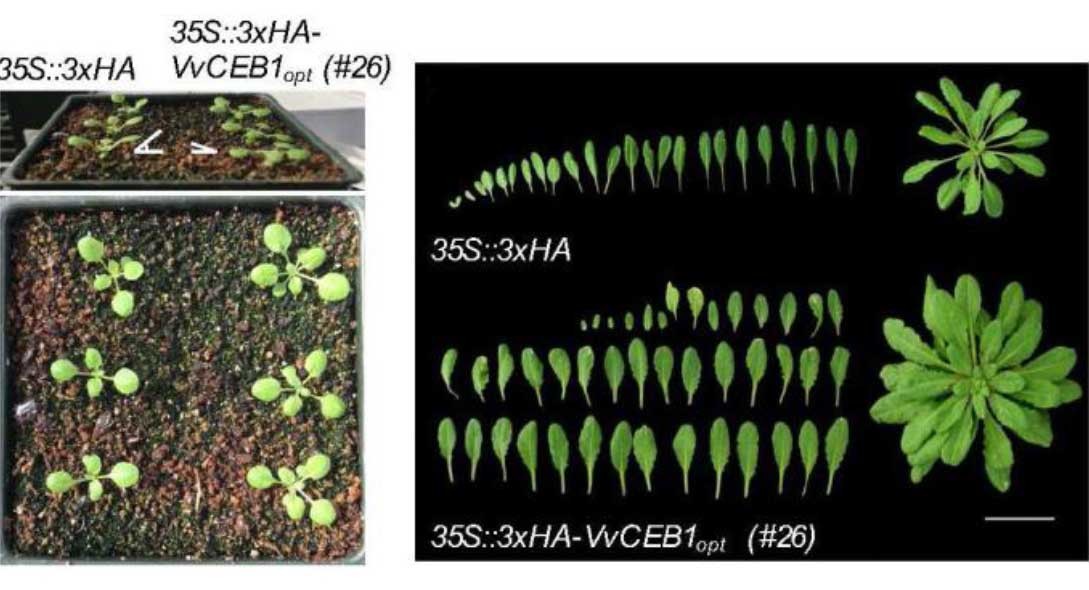博文
Plant Biotechnol J:葡萄基因转拟南芥提升植物生物量和生殖产量
||
A Vitis vinifera basic helix-loop-helix transcription factor enhances plant cell size, vegetative biomass, and reproductive yield
First author: Sung Don Lim; Affiliations: University of Nevada (内华达大学): Reno, USA
Corresponding author: John C. Cushman
Strategies for improving plant size are critical targets for plant biotechnology to increase vegetative biomass or reproductive yield. To improve biomass production, a codon-optimized helix-loop-helix transcription factor (VvCEB1opt) from wine grape (酿酒葡萄) was overexpressed in Arabidopsis thaliana resulting in significantly increased leaf number, leaf and rosette area, fresh weight, and dry weight. Cell size, but typically not cell number, was increased in all tissues resulting in increased vegetative biomass and reproductive organ size, number, and seed yield. Ionomic analysis of leaves revealed the VvCEB1opt﹐verexpressing plants had significantly elevated, K, S and Mo content relative to control lines. Increased K content likely drives increased osmotic potential (渗透势) within cells leading to greater cellular growth and expansion. To understand the mechanistic basis of VvCEB1opt action, one transgenic line was genotyped using RNA㏒eq mRNA expression profiling and revealed a novel transcriptional reprogramming network with significant changes in mRNA abundance for genes with functions in delayed flowering, pathogen-defense responses, iron homeostasis, vesicle-mediated (囊泡介导的) cell wall formation, and auxin-mediated signaling and responses. Direct testing of VvCEB1opt-overexpressing plants showed they had significantly elevated auxin content and a significantly increased number of lateral leaf primordia (侧叶原基) within meristems relative to controls confirming that cell expansion and organ number proliferation was likely an auxin-mediated process. VvCEB1opt-overexpression in Nicotiana sylvestnis (林烟草) also showed larger cells, organ size, and biomass demonstrating the potential applicability of this innovative strategy for improving plant biomass and reproductive yield in crops.
增加植物大小是一种提升生物量和生殖产量的重要植物生物技术手段。为了提升生物产量,作者将葡萄中密码子优化的螺旋-环-螺旋转录因子VvCEB1opt。在拟南芥中过表达,结果转基因拟南芥的叶片数量、叶片和莲座面积及干、湿重均得到显著的增加。细胞大小,而非细胞数量的增加导致了生物量和生殖器官大小、数量及种子产量的增加。叶片的元素分析显示相对于对照组,VvCEB1opt过表达的植株显著增加了钾、硫及钼的含量。钾含量的增加会驱动细胞内渗透式的增加,进而导致了更多的细胞生长和扩增。为了了解VvCEB1opt发挥作用的基础,作者利用RNAseq mRNA表达谱对其中一个转基因株系进行了基因分型,揭示了一个新的转录重编程网络,其中作用于延迟开花、病原防御响应、铁稳态、囊泡介导的细胞壁形成以及生长素介导的信号转导和响应基因表达丰度改变显著。对于VvCEB1opt过表达植株的检测显示其具有显著提高的生长素含量和显著提升的分生组织中侧叶原基数量,进一步表明细胞扩增和器官数量的增值极有可能是由生长素所介导。在林烟草中过表达VvCEB1opt同样能够增加细胞大小、器官大小及生物量,显示这个策略有很大的潜力用于提升作物的生物量和生殖产量。
通讯:John C. Cushman (https://www.unr.edu/molecular-biosciences/faculty/john-cushman)
�
�个人简介:1982年,伍西努斯学院,学士;1984年,罗格斯大学,硕士;1986年,罗格斯大学,博士。
研究方向:景天酸代谢CAM的功能基因组,研究CAM的表达是如何受到环境胁迫和生物钟调控的;热带兰花景天酸代谢的进化起源等。
doi: https://doi.org/10.1111/pbi.12898
Journal: Plant Biotechnology Journal
First Published date: 09 March, 2018
(P.S. 欢迎关注微信公众号:微信号Plant_Frontiers)
https://blog.sciencenet.cn/blog-3158122-1104788.html
上一篇:Genome Research:NA甲基化影响拟南芥基因组减数分裂DSB分布
下一篇:Plant Biotechnol J:GWAS解析大豆抗白霉病的遗传结构
全部作者的其他最新博文
- • Plant Physiology:CsMADS3促进柑果中的叶绿素降解和类胡萝卜素合成(华中农业大学)
- • Molecular Plant:LBD11-ROS反馈调节作用于拟南芥的维管形成层增殖和次生生长(浦项科技大学)
- • Science Advances:根结线虫通过调控植物的CLE3-CLV1模块,促进侵染进程(日本熊本大学)
- • Nature Communications:油菜素内酯参与植物营养生长期转变的分子机制解析(浙江农林大学)
- • Current Biology:光合作用产生的蔗糖驱动侧根“生物钟”(德国弗莱堡大学)
- • PNAS:花同源异型基因在叶中被抑制、花中被激活的分子机制(南卡罗来纳大学)

